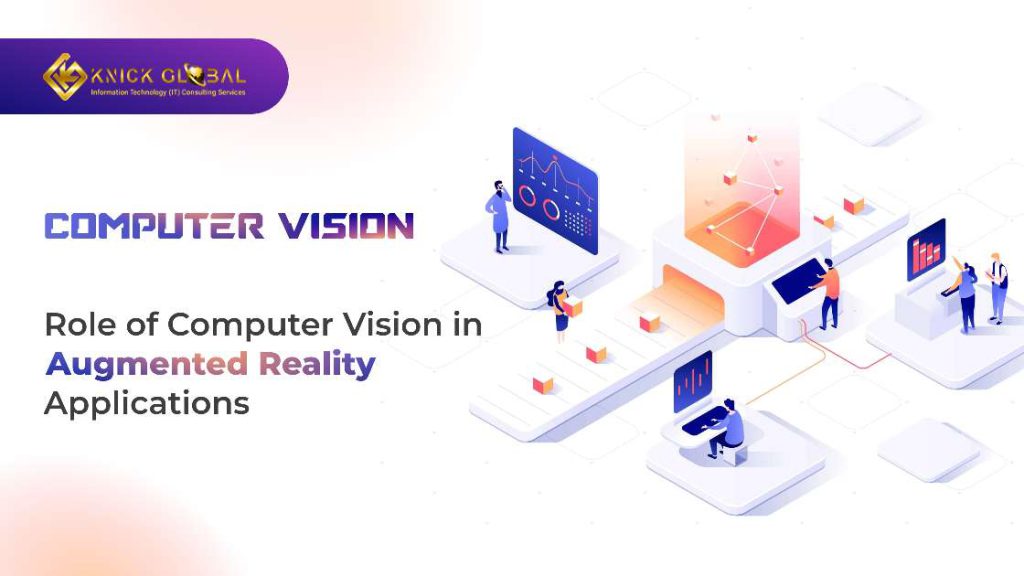Role of Computer Vision in To Augmented Reality Application
Augmented Reality: Blending Realities AR enhances our perception of reality by overlaying digital elements onto our physical surroundings. Imagine pointing your phone at a landmark and instantly receiving historical facts, or shopping for furniture and visualizing how a couch would look in your living room—all possible thanks to AR. This technology doesn’t just add a layer to reality; it transforms our interaction with the world around us. The Backbone: Computer Vision At the heart of AR lies computer vision, a field of AI that enables machines to interpret and analyze visual data from the world. It’s what allows your AR app to recognize a face, identify objects, or even navigate through a space. Computer vision provides the “eyes” that AR needs to see and understand the real world, making it possible to blend digital and physical realities seamlessly. Core Technologies in AR: Bringing Vision to Life Now that we have a foundational understanding, let’s delve into the specific computer vision technologies that power AR applications. Object Recognition and Tracking Object recognition and tracking are fundamental to creating immersive AR experiences. This technology enables AR systems to identify objects in the real world and track their movements, allowing digital elements to interact with them in real-time. For instance, in an AR game, digital characters can interact with your surroundings, creating a more immersive experience. Similarly, in retail, this technology can enhance the shopping experience by enabling virtual try-ons and product visualizations. Simultaneous Localization and Mapping (SLAM) For AR applications to function effectively, they need to understand their position in the real world—a task made possible by SLAM technology. SLAM allows devices to create a map of their surroundings while simultaneously keeping track of their location. This is crucial for applications like navigation or games, where digital content needs to stay anchored to specific locations, even as you move around. It’s what keeps that virtual dinosaur standing on your coffee table, no matter where you go. Depth Sensing and 3D Reconstruction Depth sensing and 3D reconstruction add another layer of realism to AR experiences. These technologies measure the distance between the device and objects in the real world, creating a more realistic and immersive experience. For example, in design applications, it allow users to see how furniture or decor would fit in their space, accurately reflecting size and scale. This technology is not just about placing objects in space; it’s about making them feel real. Diverse Applications: AR in Action With these technologies in place, AR can be applied across a wide range of industries, each benefiting from the unique capabilities of computer vision. Entertainment and Gaming The entertainment and gaming industries have been early adopters of AR, using it to create new ways to engage audiences. Games like Pokémon GO have shown how AR can turn the world into a playground, blending digital creatures into our everyday environments. Beyond gaming, AR is being used in movies and theater, offering interactive storytelling experiences that invite audiences to become part of the story. Retail and E-commerce In retail, AR is changing the way we shop. Virtual try-ons allow customers to see how clothes, accessories, or makeup will look on them before making a purchase. Home decor apps let you visualize furniture in your space, helping to make buying decisions easier and more confident. By bridging the gap between online and offline shopping, AR is enhancing the customer experience and reducing the number of returns. Healthcare and Medical Training The healthcare sector is also benefiting from AR. Surgeons can use AR to overlay medical images onto patients during procedures, providing a clearer view of internal structures. Medical students and professionals can practice procedures in a virtual environment, gaining experience without risk. AR is also being used to educate patients, making complex medical information more accessible and easier to understand. Education and Training In education, AR is making learning more interactive and engaging. Imagine students studying history and being able to see historical events come to life in the classroom, or biology students exploring 3D models of the human body. AR provides a hands-on learning experience that can make abstract concepts more concrete and easier to grasp. It’s not just for kids, either—AR is being used in vocational training, providing real-world practice in a virtual setting. Industrial and Manufacturing AR is also making waves in the industrial and manufacturing sectors. From providing real-time information and instructions on machinery to guiding assembly processes, AR is helping improve efficiency and accuracy. It’s being used for maintenance, training, and quality control, offering a safer and more efficient way to manage complex tasks. In manufacturing, AR can visualize the assembly process, making it easier to spot potential issues before they become problems. Challenges and Future Directions While the potential of AR is vast, several challenges must be addressed to realize its full potential. Current Challenges Despite its many benefits, AR faces several challenges. Technical limitations, such as the need for high-quality sensors and robust computer vision algorithms, can hinder the development of seamless AR experiences. There’s also the challenge of making AR accessible and user-friendly, ensuring that it works well across different devices and platforms. Additionally, privacy concerns and data security are critical issues that need to be addressed as AR becomes more integrated into our daily lives. The Future of Computer Vision in AR Looking ahead, the future of AR and computer vision is bright. Advances in AI and machine learning are set to enhance the capabilities of AR, making it more accurate and responsive. The rollout of 5G networks will also play a crucial role, providing the speed and bandwidth necessary for real-time AR applications. As these technologies evolve, we can expect to see AR become even more integrated into our daily lives, from navigation and communication to shopping and entertainment. Conclusion As we continue to explore the frontiers of technology, the synergy between computer vision and AR offers endless possibilities. From revolutionizing industries to enhancing everyday experiences, this powerful combination is set to transform our










